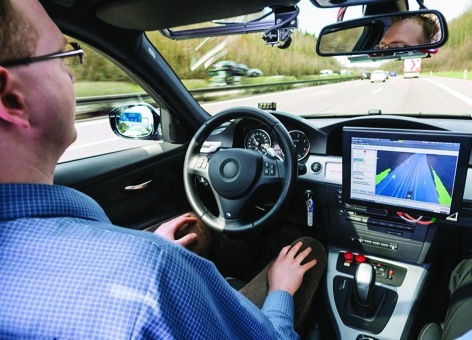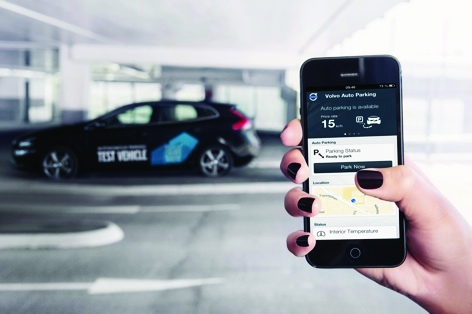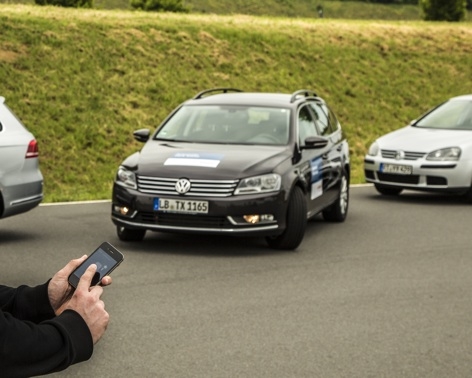From Michael Knight’s KITT to the Batmobile, the car that drives itself is a well-worn staple of science fiction. And like many other staples of science fiction, it’s a technology that’s now edging ever closer to reality.
Indeed, car-makers, technology suppliers and transport authorities around the world are increasingly viewing the autonomous car as the key to a safer, less congested and more energy efficient road system.
Across Europe, automobile companies including BMW, Volvo and Bosch have all recently tested driverless cars on public roads, and regard autonomous technology as being a key area of their future business.

In the US, search engine giant Google, which has a test fleet of around 10 autonomous cars, has successfully lobbied for changes to legislation in Nevada, Florida and California that enable it to test its technology on the road. And here in the UK the government last month confirmed that road trials of a driverless car developed by Oxford University and Nissan will begin later this year.
“Car-makers tend to talk of driverless cars as an evolutionary process
The concept of the driverless car attracts a fair degree of scepticism; many people still enjoy driving, and there’s also an understandable nervousness about ceding control of something as potentially dangerous as an automobile to a computer.
But despite its sci-fi credentials, the technology required to enable a car to drive itself is actually less revolutionary than one might think. Many of today’s high-end luxury cars already have systems such as lane assist technology and adaptive cruise control. And over the coming years other features, such as fully autonomous parking technology (which Bosch hopes to launch by 2015) look set to become increasingly commonplace. In a sense, the driverless car is in fact the logical conclusion of the development of these kind of systems. Car-makers tend to talk of it as an evolutionary process.

‘We’re developing a portfolio of automated functions in a step-by-step process towards autonomy with different technologies appearing at different tines,’ said Volvo’s Jonas Ekberg, who heads up the Swedish company’s research in the area. Meanwhile, talking recently at Bosch’s annual automotive symposium in Germany, the division’s outgoing chief Bernd Bohr talked about the ‘many individual steps’ his company is taking towards its vision of ‘accident-free and automated driving’.
Nevertheless — bringing all of these technologies together and completely removing the driver from the loop presents some major technical and regulatory challenges.
One of the companies leading the way in Europe is German automotive specialist Bosch, one of the world’s biggest suppliers of advanced safety and driver-assistance systems.
“If you take the driver out of the loop, you’re not allowed to have any failures in the system that you cannot handle
Michael Fausten, Bosch
Michael Fausten, who heads up the company’s research in |the area, explained hat there are a number of key functions an autonomous car has be able to perform. ‘It must know what is happening around itself; it must know where it is and where it wants to go; it must have the reasoning and decision-making capability to plan a safe trajectory; and finally, it needs the “muscles” or actuators that can take control of the vehicle’s steering and control systems.’
Car-makers seem to be taking a broadly similar approach to solving these problems: using advanced imaging systems to gather information about a vehicle’s surroundings that is then cross-checked against detailed GPS and map data.
Bosch’s vehicle gathers data using radar and ultrasonic sensors, a stereo video camera and a spinning roof-mounted laser scanner (LIDAR), which generates a detailed 3D map of the environment. Google’s fleet of autonomous Toyota Priuses also uses a laser scanner coupled with GPS and other sensors to build up an image of its surroundings. Meanwhile, BMW has adopted a similar approach but mounted its laser scanner below the front grill, where it is used to generate an image of what lies ahead of the car. The shared long-term vision among all these companies and many others is that all of this local intelligence will feed into a vast pool of data relating to what’s happening on the roads. Cars will be able to talk to each other and to intelligent road infrastructure, and plan their routes, trajectories and driving styles accordingly.
In recent months, both Bosch and BMW have announced successful trials on sections of the German autobahn — a significant move away from the test track and into the more dynamic and unpredictable environment of a real-life road.
‘The German autobahn is a very challenging environment,’ said Fausten. ‘You have very dense traffic, very high-speed vehicles, and high speed differences between traffic participants. But the vehicle is doing quite well — we are producing quite good information on what is happening all around the vehicle.’
The road tests have also provided some valuable examples of the technology’s growing ability to cope with the unexpected. Fausten recalls one particular incident where the car pulled out to overtake just as another vehicle travelling at speed in the outside lane began pulling in — a potentially hazardous scenario familiar to anyone who’s ever driven on a motorway.
As currently required by law, an engineer was poised to grab the steering wheel and take control, but the vehicle dealt with the situation on its own. ‘It was really marvellous,’ said Fausten. ‘The vehicle recognised it and immediately re-planned the trajectory and went back to the lane where it came from. It was a relief seeing a system that is designed to be intelligent and take decisions on its own doing what it is expected to do.’
Fausten’s anecdote is a reminder of the chaotic and unpredictable environment that lies in wait for the first autonomous vehicles. And while some researchers envision a fully autonomous future with relatively easy-to-manage road networks, it could be decades before anything like this becomes a reality. Volvo’s Jonas Ekberg, another engineer with direct experience of operating driverless cars on the road, believes that the mixed traffic challenge will always be an issue. ‘I don’t really see that we can have dedicated roads for autonomous vehicles,’ he said. ‘It won’t happen that way for 20 or 50 years or maybe it never will, so we will need to be able to mix with manually driven vehicles.’

With this in mind, a team of robotics specialists from Oxford University is taking a different approach and working on the development of a low-cost autonomous navigation system that doesn’t rely on existing infrastructure or communication with other intelligent vehicles.
Led by Prof Paul Newman, the EPSRC-funded RobotCar team has developed an autonomous Nissan Leaf, which, although not yet as sophisticated as some of the other autonomous vehicles around the world, boasts a more affordable approach to navigation.
Based on low-cost lasers and cameras, Newman’s system is aimed at making the technology more affordable for the masses. ‘We can localise on the roads with a laser that costs about £7,000, but what we’re working on now is how you can do this with just cheap cameras. If you can do it with cameras you can then think about doing this with just tens of dollars,’ he said.
One of the keys to the RobotCar approach is that the vehicle doesn’t need to rely on expensive satellite navigation technology to know where it is. ‘I don’t need to communicate with every car and the road to be able to drive home safely… so must we ensure that machines do?’ explained Newman.
He believes it is an area of research where the UK could have a major impact and is keen to stress that Google isn’t ‘the only show in town’. ‘It’s not just happening in California,’ Newman toldThe Engineer. ‘The gene pool we pull from in the UK is the same as at Google — our team’s got 30 people and the Google team is the same size.’
Newman’s vision is shared by the UK government’s Department for Transport (DfT), which, in its recently published ‘Action for Roads’ report, predicts a world where by 2040, semi-autonomous vehicles are commonplace on our roads. The report also revealed that the DfT is looking at working with industry and researchers on a close study of the hurdles the technology faces and how the UK can best exploit its expertise in the area.
The fully autonomous car will not appear overnight. Despite some hugely impressive prototype vehicles, the car industry and the road regulators are rightly conservative. But a number of technologies slated to appear soon on production vehicles — including traffic-jam-assist technology that will take control of the vehicle on congested highways — will bring the autonomous dream a step closer to reality.
Newman believes that traffic-jam assist will be a welcome first step for driverless car technology. ‘It seems the most sensible place for it to start,’ he said. ‘No one ever advertises a car and says “buy this car and you’ll be happy in a traffic jam”… they always say “buy this car and you’ll be able to drive down route one with all the beautiful people at 80mph”. That’s not actually where we want a car to drive us. The thing that drives us crazy about cars is congestion so shouldn’t we be starting there?’
Another important trend in the emergence of driverless technology is the way in which it will evolve alongside other automotive systems, in particular more efficient powertrains.
‘We know many strategies that can save energy,’ said Bosch’s Fausten. ‘But we can only suggest to a driver that they operate the vehicle in a very economic way. If you have an automated vehicle you can tell it how to drive and it will do so.’
Volvo’s Ekberg added that a vehicle able to intelligently plan its own route and reduce its drag by joining closely-packed-together, autonomous road-trains — a lesson learned from Volvo and Ricardo’s recently concluded SARTRE project — could make much better use of battery power, an important issue across the automotive industry.
The general view seems to be that automated driving will appear first on highways, where it has already been tested and where traffic conditions are more predictable. Moving the technology into a more complex urban traffic environment will
be an order of magnitude more challenging.
‘There will surely be a push to bring this technology into urban environments as well,’ said Fausten. ‘But the big challenge is that in comparison to a highway you have a very complex traffic situation. On the autobahn you have just vehicles driving at more or less the same speed and in the same direction and the prediction of what will happen next is fairly easy.
‘If you have pedestrians, they have a rather difficult motion pattern for prediction and then you have bicycles and small motorcycles.
One real challenge for the technology is children — they are completely unpredictable.’
Fausten said the key to enabling autonomous vehicles to operate in these more dynamic environments will be teaching
a vehicle’s perception system to recognise all the types of situation it will encounter. There is, he said, already some progress in this area. ‘We’re teaching our cameras to recognise a pedestrian for our automated emergency braking system, but this has to be further developed, further improved and then we have to learn how reliable it is and whether it can predict each and every situation.’

So far, all autonomous vehicle tests have required the presence of a human in the driving seat, ready to take over in the event that the vehicle gets into difficulties. But how realistic is the long-term goal of completely removing the driver from the loop?
Bosch’s Fausten envisions cars equipped with a so-called ‘highway pilot’ mode by the middle of the next decade, but said that such a system will require a big leap forward. ‘If you take the driver out of the loop,’ he said, ‘you’re not allowed to have any failure in the system that you cannot handle. The biggest challenge here is to foresee a system that can cope with almost every situation. It is not just making another functionality as we have done in the past — this will take a long time.’
Ekberg, however, believes that there will always be a role for the driver. ‘The car will take responsibility but will need to be able to hand responsibility back. It may come across exceptional things that it cannot handle — for instance, an accident on the road or some environmental condition such as a snow storm that it is not designed for.’
European car-makers must also work within the framework of the Vienna Convention, which is potentially a major regulatory obstacle to the roll-out of fully autonomous vehicles. Last amended in 1968, the convention states that ‘every driver shall, at all times, be able to control his vehicle or to guide his animal’.
Fausten said that while existing and planned driver assistance technologies are in line with these regulations, the rules will need to be revised to allow driverless car operation. ‘If we talk about taking the driver out of the loop then there needs to be some regulatory change,’ he said. ‘But the authorities are aware of it; the US, EU and Japan are all dedicating attention to this topic. We’re confident it will be resolved.’
Others claim that the regulations are open to interpretation. ‘It’s really a matter of words,’ said Ekberg. ‘The original Vienna convention was written in 1940 and says that the driver should always be able to control his vehicle or animals. But what does “be able to control mean”? Does it mean control all the time, or control when it’s needed? The Swedish authorities interpret it in such a way that it doesn’t prohibit highly automated driving.
There are undoubtedly some tough challenges ahead. Engineers have only scratched the surface of some of the more complex technical problems. And regulations, consumer acceptance issues and cost will undoubtedly slow the deployment of driverless technology. But despite this, there is a growing consensus that it will ultimately make a major difference to the way in which we get from A to B.
‘Rarely can you perceive a technology that’s so obviously going to happen,’ said Newman. ‘Computing has changed the world in terms of healthcare, finance, entertainment and communication. It is yet to change transport — but it will.’




Red Bull makes hydrogen fuel cell play with AVL
Formula 1 is an anachronistic anomaly where its only cutting edge is in engine development. The rules prohibit any real innovation and there would be...